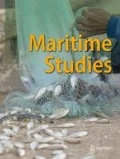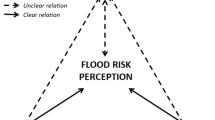Abstract
In this article, we investigate how the uncertain consequences of sea lice agents on the environment affect the management process, focusing on the coastal shrimp in Norway. In this context, the key stakeholders (shrimp fishers and aquaculture owners) have conflicting interests and understand uncertainty from different perspectives. We ask: (1) How do fishers and aquaculture representatives translate uncertainty into risk, and do they link uncertainty to the precautionary approach or not? (2) How is uncertainty dealt with scientifically and related to decisions made by the authorities? Finally, we address organizational aspects related to a “post-normal approach” and ask: (3) Is it possible to organize the risk assessment process differently, to ensure more effective and legitimate advice? In order to answer these questions, we understand these issues as post-normal ones, and lean on both Science and Technology Studies and Risk Governance theory. We use a mix of social scientific methods including literature review, participatory observation, and semi-structured interviews. Our findings indicate that since the effect of sea lice agents is an uncontrollable problem ridden with uncertainty, science alone is insufficient, calling for a more participatory approach.


Similar content being viewed by others
Notes
The Norwegian Reference Fleet is an IMR run project using fishers to collect data (see https://www.hi.no/temasider/referanseflaten/nb-no)
See https://www.barentswatch.no/fiskehelse for an updated map over sea lice numbers. These numbers are reported to the Norwegian Food Safety Authority every week.
Cypermethrin, deltamethrin, azamethiphos, hydrogen peroxide
Teflubenzuron, diflubenzuron, emamectin benzoate
See for instance Aftenposten, 2014 (https://www.aftenposten.no/norge/i/21xeR/Bruken-av-gifitige-lakselusmidler-eksploderer) and a large number of articles in the fisheries papers such as “Fiskeribladet fiskaren” https://fiskeribladet.no/.
The Norwegian Fishermen’s Association sent the first letter to the Ministry of Trade, Industries and Fisheries demanding a full stop in the use of kitin synthesis prohibitors in 2011.
See for instance Ystmark, 16 September 2015, in interview with Hagen JM. (2016) Ingen føre-var i havbruksnæringa. Fiskeribladet.https://fiskeribladet.no/nyheter/?artikkel=48982
Throughout the reports from 2011 to 2017, the risk report was organized the same way. In their latest report (February 2018), however, the risk report is organized a bit differently.
Recently, the NSL changed its name to “Sjømatbedriftene”.
Since 2003, the Norwegian Directorate of Fisheries has gathered information from the local fishermen’s organization to map spawning grounds and fishing fields, available here: https://kart.fiskeridir.no/ (see for instance Brattland 2012 for more information about this process).
References
Almås, A.K and Ratvik, I. 2017. Sjøkart mot 2050. SINTEF rapport. https://www.sintef.no/contentassets/b26c5aed53be4385b4ab770c24761a95/sjokart%2D%2Dendelig-versjon-7.april-2017.pdf.
Anon. 2016. The status for Norwegian Atlantic salmon populations in 2016 report from the Norwegian Scientific Advisory Committee for Atlantic Salmon Management. Norway.
Berkes, F. 1999. Sacred ecology: Traditional ecological knowledge and resource management. Philadelphia: Taylor & Francis.
Bjørkan, M. 2011. Fishing for advice - the case of the Norwegian fishing fleet. PhD thesis. Tromsø: University of Tromso, Faculty of Biosciences, Fisheries and Economics, Norwegian College of Fisheries Science.
Bjørkan, M., and K. Hiis Hauge. 2019. Kunnskapsbasert forvaltning og dilemmaer knyttet til usikkerhet. In Interessekonflikter i forskning, ed. H. Ingierd, I. Bay-Larsen, and K. Hiis Hauge. Oslo: NENT. https://doi.org/10.23865/noasp.63.
Bjørkan, M., and S. Veland. 2019. Beyond consensus: Perceptions of risk from petroleum developments in Lofoten, Vesterålen and Senja, Norway. ICES J Mar Sci. https://doi.org/10.1093/icesjms/fsz056.
Brattland, C. 2012. Monstertorsk, vitenskap og politikk i Storfjord. Produksjon av fiskerkunnskap i forvaltningen. Senter for samiske studier, skriftserie nr. 18. Tromsø.
Brattland, C. 2013. Proving fishers right. Effects of the integration of experience-based knowledge in ecosystem-based management. Acta Borealia: A Nordic Journal of Circumpolar Societies 30 (1): 39–59.
Buanes, S.A., S. Jentoft, G.R. Karlsen, A. Maurstad, and S. Søreng. 2004. In whose interest? An exploratory analysis of stakeholders in Norwegian coastal zone planning. Ocean & Coastal Management 47: 207–223. https://doi.org/10.1016/j.ocecoaman.2004.04.006.
Callon, M. 1999. The role of lay people in the production and dissemination of scientific knowledge. Science, Technology & Society 4 (1): 81–94 London. https://journals.sagepub.com/doi/pdf/10.1177/097172189900400106?casa_token=qmJ-qbF_LUoAAAAA:yIPwbLXOOEm_j4a1T3HBVAlwZp03Sa89rgTrlU1L6270UUMXqEO3hiGuue_Y9H55kb_vyfF9IdEd.
Dreyer, M., and O. Renn. 2008. Some suggestions for a structured approach to participation in food risk governance with a special emphasis on the assessment-management interface. In European risk governance its science, its Inclusiveness and its effectiveness, ed. E. Vos. Mannheim: CONNEX Report Series.
Fiskeribladet. 2016. Ingen "føre var" i havbruksnæringa. 16th of September 2016. https://fiskeribladet.no/nyheter/?artikkel=48982.
Friends of the Earth Norway. 2016. Hva gjør utslipp fra 400 millioner oppdrettslaks med havet vårt? Kloakk, lusemidler, medisiner, miljøgifter og myriader av lakselus flyter rett ut i fiskens fødestuer i Norske hav og fjorder. Facebook page accessed 13th of June, 2018.
Funtowicz, S.O., and J.R. Ravetz. 1990. Uncertainty and quality in science for policy. Dordrecht (Netherlands): Kluwer.
Funtowicz, S., and J. Ravetz. 1993. Science for the post-normal age. Futures 25: 739–755. https://doi.org/10.1016/0016-3287(93)90022-L.
Funtowicz, J.R., and J. Ravetz. 2003. Post-normal science. Internet Encyclopaedia of Ecological Economics. International Society for Ecological Economics.
Gleick, P.H. 2007. Testimony to the Senate Committee on Commerce, Science, and Transportation. For the Hearing on Climate Change Research and Scientific Integrity. Threats to the Integrity of Science. Committee on Commerce, Science, and Transportation. http://pacinst.org/wp-content/uploads/2007/02/Gleick_Senate_Commerce_2-7-07.pdf.
Grefsrud, E.S., K. Glover, B.E. Grøsvik, V. Husa, Ø. Karlsen, T. Kristiansen, B.O. Kvamme, O.B. Mortensen, L.H. Stien, and T. Svåsand(red) (2018). Risikorapport norsk fiskeoppdrett 2018. Fisken og havet, særnr. 1–2018. Hagen, J.M. (2016) Ingen føre-var i havbruksnæringa.Fiskeribladet. https://fiskeribladet.no/nyheter/?artikkel=48982.
Hersoug, B., and J.P. Johnsen. 2012. Kampen om plass på kysten -interesser og utviklingstrekk i kystsoneplanleggingen. Oslo: Universitetsforlaget.
Holm, Petter. 2003. Crossing the border. Maritime Studies (MAST) 2(1):5–33.
IMR. 2016a. Reke i fjorder og kystnære områder. http://www.imr.no/filarkiv/2016/05/reke_kyst_og_fjord.pdf/nb-no.
IMR. 2016b. consultative Statement: https://www.regjeringen.no/no/dokumenter/horing%2D%2D-tiltak-mot-negative-miljoeffekter-av-medikamentell-behandling-mot-lakselus/id2505480/?factbox=horingssvar.
Jaeger, C.C., O. Renn, E.A. Rosa, and O. Renn. 2001. Uncertainty and rational action. London: Earthchan Publications Ltd. https://doi.org/10.4324/9781315071817.
Jasanoff, S. 1990. The fifth branch: Science advisers as policymakers. Cambridge: Harvard University Press.
Jasanoff, S., G.E. Markle, J.C. Petersen, and T. Pinch. 1995. The handbook of science and technology studies. London: Sage publications.
Johannes, R.E., M.M.R. Freeman, and R.J. Hamilton. 2000. Ignore fishers knowledge and miss the boat. Fish and Fisheries 1(3):257–271. https://doi.org/10.1111/j.1467-2979.2000.00019.x.
Joks, S. and J. Law. 2016. Sámi Salmon, State Salmon: LEK, Technoscience and care. http://www.heterogeneities.net/publications/JoksLaw2016SamiSalmonScienceSalmon.pdf.
Klinke, A., and O. Renn. 2002. A new approach to risk evaluation and management: Risk-based, precaution-based, and discourse-based strategies. Risk Anal 22: 1071–1094. https://doi.org/10.1111/1539-6924.00274.
Klinke, A., and O. Renn. 2010. Risk governance: Contemporary and future challenges. In Regulating chemical risks: European and global challenges, ed. J. Eriksson, M. Gilek, and C. Rudén. Springer. https://doi.org/10.1007/978-90-481-9428-5_2.
KPB. 2018. Indeks Nordland: En rapport om utviklingen gjennom 2017 og utsiktene for 2018. Kunnskapsparken Bodø. https://indeksnordland.no/wp-content/uploads/2019/01/2018.pdf.
Lauer, M., and S. Aswani. 2009. Indigenous ecological knowledge as situated practices: Understanding fishers’ knowledge in the Western Solomon Islands. Am Anthropol 111: 317–329.
Linke, S., M. Dreyer, and P. Sellke. 2011. The regional advisory councils: What is their potential to incorporate stakeholders knowledge into fisheries governance? Ambio: A Journal of the Human Environment 40: 133–143.
Liu, Y., J.O. Olaussen, and A. Skonhoft. 2011. Wild and farmed salmon in Norway—A review. Mar Policy 35: 413–418. https://doi.org/10.1016/j.marpol.2010.11.007.
Lundberg, A.K., T. Richardson, and E. Hongslo. 2018. The consequences of avoiding conflict: Lessons from conservation planning for Europe’s last wild reindeer. J Environ Plan Manag 62: 266–285. https://doi.org/10.1080/09640568.2017.1409197.
Mackinson, S. 2001. Integrating local and scientific knowledge: An example in fisheries Science. Environ Manag 27 (4): 533–545.
Marine Harvest. 2016. Tiltak mot negative miljøeffekter av medikamentell behandling mot lakselus. https://www.regjeringen.no/no/dokumenter/horing%2D%2D-tiltak-mot-negative miljoeffekter-av-medikamentell-behandling-mot lakselus/id2505480/?factbox=horingssvar.
Mouffe, C. 2005. On the political. London and New York: Routledge, Taylor and Francis Group.
Mouffe, C. 2013. Agonistics: Thinking the world politically. London: Verso.
Nature Diversity Act. 2009. Lov om forvaltning av naturens mangfold. Klima- og miljøverndepartementet.
Neis, Barbara, and L. Felt (Eds.). 2000. Finding our sea legs: Linking fishery people and their knowledge with science and management. St Johns: ISER books.
NENT. 2016. Forskningsetiske retningslinjer for naturvitenskap og teknologi. The Norwegian National Research Ethics Committees: https://www.etikkom.no/globalassets/documents/publikasjoner-som-pdf/60124_fek_retningslinjer_nent_digital.pdf.
NSL. 2016. Norwegian Fishermens Associoation. Consultative statement . https://www.regjeringen.no/no/dokumenter/horing%2D%2D-tiltak-mot-negative-miljoeffekter-av-medikamentell-behandling-mot-lakselus/id2505480/?factbox=horingssvar.
NFD. 2016. Strammer inn reglene for lusemiddelbruk. Ministry of Trade, Industry and Fisheries. https://www.regjeringen.no/no/aktuelt/strammer-inn-reglene-for-lusemiddelbruk/id2505478/.
NSC. 2018. Norwegian Seefood Council. Sjømateksport for rekordhøye 94,5 milliarder i 2017. Norges Sjømatråd. https://seafood.no/aktuelt/nyheter/sjomateksport-for-rekordhoye-945-milliarder-i-2017/: Norges Sjømatråd.
NSF. 2016. Norwegian Seafood Federation.Tiltak mot negative miljøeffekter av medikamentell behandling mot lakselus. https://www.regjeringen.no/no/dokumenter/horing%2D%2D-tiltak-mot-negative-miljoeffekter-av-medikamentell-behandling-mot-lakselus/id2505480/?factbox=horingssvar.
Olafsen, T., U. Winther, Y. Olsen, and J. Skjermo. 2012. Verdiskaping basert på produktive hav i 2050. På oppdrag fra NTVA og DKNVS. Oslo. SINTEF rapport. https://www.sintef.no/globalassets/upload/fiskeri_og_havbruk/publikasjoner/verdiskaping-basert-pa-produktive-hav-i-2050.pdf.
Oreskes, N., and E.M. Conway. 2010. Merchants of doubt. Bloomsbury Press.
Renn, O. 1998. Three decades of risk research: Accomplishments and new challenges. Journal of Risk Research 1: 49–71 http://www.ask-force.org/web/Discourse/Renn-Three-decades-risk-research-accomplishments-new-challenges-1998.pdf.
Robertsen, R., O. Andreassen, B. Hersoug, K.M. Karlsen, T. Osmundsen, A.M. Solås, B. Sørgård, F. Asche, R. Tveterås. 2016. Regelrett eller rett regel? Håndtering og praktisering av regelverket for havbruksnæringen.Nofima rapportserie. Tromsø. https://brage.bibsys.no/xmlui/handle/11250/2417179.
Sandersen, H., and I. Kvalvik. 2015. Access to aquaculture sites: A wicked problem in Norwegian aquaculture development. Maritimes Studies 14. https://doi.org/10.1186/s40152-015-0027-8.
Sandvik, K. 2018. HI er bekymret for sammenfall av avlusning og krilldød. Fiskeribladet fiskaren. https://fiskeribladet.no/nyheter/?artikkel=58758.
Scott, D. 2016. Framing and responding to scientific uncertainties: Biofuels and synthetic biology at the convention on biological diversity. Jurimetrics J: 245–260. https://www.americanbar.org/content/dam/aba/administrative/science_technology/2016/framing_and_responding.authcheckdam.pdf.
Shackley, S., and B. Wynne. 1996. Representing uncertainty in global climate change science and policy: Boundary-ordering devices and authority. Sci Technol Hum Values 21: 275–302.
St.Mld.42. 2000–2001. Biologisk mangfold - sektoransvar og samordning. Oslo: Miljøverndepartementet. https://www.regjeringen.no/en/dokumenter/report-no.-42-to-the-storting-2000-2001/id194978/.
St.prp.nr.31. 1982–83. Om samtykke til å ratifisere konvensjonen av 2. mars 1982 til vern av laks idet nordlige Atlanterhav. Oslo: Miljøverndepartementet. https://stortinget.no/nn/Saker-og-publikasjonar/Stortingsforhandlingar/Lesevisning/?p=1982-83&paid=2&wid=a&psid=DIVL678&s=True.
Sterud, E. 2016. Aftenposten. [Wild Salmon Sacrificed]. www.aftenposten.no/meninger/debatt/Ofres-villaksen%2D%2DErik-Sterud-424565b.html.
Stirling, A. 2007. Risk, precaution and science: Towards a more constructive policy debate. Talking point on the precautionary principle. EMBO Rep 8: 309–315. https://doi.org/10.1038/sj.embor.7400953.
Strand, R., and D.H. Oughton. 2009. Risk and uncertainty as a research ethics challenge. NENT report, 42. Oslo: The National Committee for Research Ethics in Science and Technology (NENT).
Strand, R., and D. Ougthon. 2009. Risk and Uncertainty. Publication no. 9. The National Committee for Research Ethics in Science and Technology (NENT).
Svåsand, T., E. Grefsrud, Ø. Karlsen, B.O. Kvamme, K. Glover, V. Husa, and T.S. Kristiansen. 2017. Risikorapport norsk fiskeoppdrett. Fisken og Havet. særnr. 2nd ed. Bergen: IMR https://www.imr.no/filarkiv/2017/05/risikorapport_2017.pdf/nn-no.
Tengö, M., E.S. Brondizio, T. Elmqvist, P. Malmer, and M. Spierenburg. 2014. Connecting diverse knowledge systems for enhanced ecosystem governance: The multiple evidence base approach. Ambio 43 (5): 579–591. https://doi.org/10.1007/s13280-014-0501-3.
Thonhaugen, M. 2017. NRK Nordland: Rekefisker: – Det har aldri vært så dårlig som i år. 04.03.17 ed. https://www.nrk.no/nordland/rekefisker_-_-det-har-aldri-vaert-sa-darlig-som-i-ar-1.13409411.NRK Nordland.
van der Sluijs, P.J. 2012. Uncertainty and dissent in climate risk assessment. Nature and Culture 7: 174–195. https://doi.org/10.3167/nc.2012.070204.
Wachinger, G., and O. Renn 2010. Risk perception and natural hazards. In: WP3 C-N (ed). Stuttgart: DIALOGIK Non-Profit Institute for Communication and Cooperative Research.
Weber, E.P., J.M. Belsky, D. Lach, and A.S. Cheng. 2014. The value of practice-based knowledge. Soc Nat Resour 27 (10): 1074–1088. https://doi.org/10.1080/08941920.2014.919168.
Wilson, D.C. 2009. The paradoxes of transparency: Science and the ecosystem approach to fisheries management in Europe. MARE publication series no. 5. Amsterdam: Amsterdam University Press.
Wilson, Douglas C, Jesper Nielsen, and Poul Degnbol (Eds.). 2003. The fisheries comanagement experience. Accomplishes, Challenges and Prospects: Kluwer Academic Publishers.
Wynne, B. 1989. Sheep farming after Chernobyl, a case study in communicating scientific information. Environment 31: 10–15.
Author information
Authors and Affiliations
Corresponding author
Ethics declarations
Conflict of interest
The authors declare that they have no conflict of interest.
Additional information
Publisher’s note
Springer Nature remains neutral with regard to jurisdictional claims in published maps and institutional affiliations.
Rights and permissions
About this article
Cite this article
Bjørkan, M., Rybråten, S. The potential impact of sea lice agents on coastal shrimp in Norway: risk perception among different stakeholders. Maritime Studies 18, 173–187 (2019). https://doi.org/10.1007/s40152-019-00141-6
Received:
Accepted:
Published:
Issue Date:
DOI: https://doi.org/10.1007/s40152-019-00141-6




